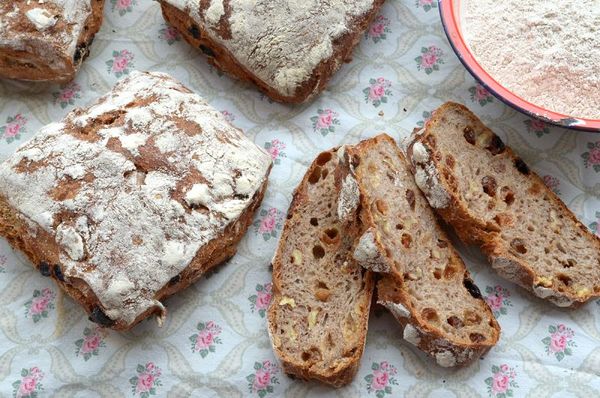Pavé with rye,nuts and raisins
by Ibán Yarza (lamemoriadelpan.com, tequedasacenar.com)
Simple, tasty and always ready. A bread full of aromas, that lasts well and is perfect for restaurants.

On many occasions with great creations, the most tasty and succulent ones generally cost more (in terms of both time and dedication), which doesn't fit in well with the frenetic pace of a restaurant. However, when we try and take shortcuts quality tends to suffer. This bread tries to get the best of both worlds: the great taste and results along with its marriage of convenience and usefulness. We do this by using the refrigerator, always a great ally. It uses dough that remains shapeless and does not ferment twice. This is pavé or cobblestone shaped bread, as we'd say in English. This is a great alternative as the dough can be put straight in the refrigerator from the oven without needing to shape it or go through the fermentation process again. It can easily be left for a couple of days in the refrigerator, which reduces the need to spend time in the kitchen preparing the dough. You can prepare it twice or three times a week and always have the dough ready to put in the oven. To finish off the rounded look, this bread uses a fermentation process that uses yeast, which makes life easy for those of us who are not used to working with natural sour dough. That being said, thanks to a generous helping of ferment, as well as being made using wholemeal rye flour, this bread has great flavour.
Ferment
- Wholemeal rye flour (better if stone ground) 300 g
- Warm water 180 g
- Fresh yeast 2 g (0.7 g dry yeast)
Final dough
- Yesterday's ferment
- Bread making flour (approx. W200) 700 g
- Water 620 g (correct water temperature depending on room temperature, end temperature of dough, 24 – 26° C)
- Salt 20 g
- Nuts 150 - 200 g
- Raisins 150 - 200 g
The ferment is prepared the day before baking. Mix the ingredients, knead the dough well until a dense ball is made and leave to rest and ferment in a closed container for 2 hours at room temperature, and then 24 hours in the refrigerator at 4° C (should you be unable to complete this part of the process you can try leaving it to ferment for 5 hours at room temperature).
The following day put all the ingredients in the planetary mixer, except the dry fruits, along with 70 - 100 g of water and let it rest. Mix it all for 3 minutes at speed level 1 and then speed level 2 (even level 3 should the correct consistency not have been achieved), and knead for 5 to 6 minutes until an intermediate development of the gluten is reached. Add the water that we had kept aside in a couple of times and knead for another 3 minutes at speed level 3. Finally, add the dried fruits and knead for one minute at speed level 1, just to achieve an even mix.
Move the dough to a rectangular bread tin that has been greased (a Gastronorm tray) and leave to ferment for two hours, folding after 60 and 120 minutes. Once folded for the second time, move to the refrigerator (cover well with cling film or a hermetically sealed container) at 4° C. After an hour, fold again and leave it to ferment for 12 to 48 hours in the fridge. In other words, you can take it out and bake the next day when needed. A good idea is to make two trays; one for tomorrow and the other for the day after.
On baking day, heat the oven to 250 – 260° C. Take out the dough and turn it over onto a surface with a good dusting of flour so it doesn't stick. Without degassing or damaging the dough's structure, shape the corners in order to form a perfect rectangle. Cut rectangular pieces that measure approximately 500 g (this isn't crucial, as its not bread for retail, but it does help the cooking process if all loaves are of a similar size). Transfer with the help of oven proof paper and place on a hot metallic tray. Steam can be created by pouring water over the other metallic tray at the base of the oven, and leave to cook for 15 minutes with the fan on minimum. Once the 15 minutes have elapsed, release the steam, open the cover and cook for another half hour at 200° C. It may be worth using the fan to help dry the bread and achieve a nice crust. Remove the bread and allow it to cool before slicing.
